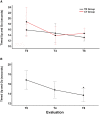Feasibility and effectiveness of a remote individual rehabilitation program for people with Parkinson's disease living in the Brazilian Amazon: a randomized clinical trial
- PMID: 37693755
- PMCID: PMC10485362
- DOI: 10.3389/fneur.2023.1244661
Feasibility and effectiveness of a remote individual rehabilitation program for people with Parkinson's disease living in the Brazilian Amazon: a randomized clinical trial
Abstract
Parkinson's disease (PD) is a chronic and progressive neurodegenerative disorder, and the current treatment involves pharmacological intervention and physiotherapy. Telerehabilitation, which involves remote support and guidance for patients undergoing rehabilitation, can potentially improve access to physiotherapy services for people with Parkinson's disease, especially those who face geographic barriers to healthcare. The primary aim of this study was to assess the feasibility and efficacy of a telerehabilitation program for people with Parkinson's disease living in an underrepresented community of the Brazilian Amazon. We conducted a parallel-group, single-center, single-blind, phase 2 randomized controlled clinical trial involving 19 participants diagnosed with Parkinson's disease from Belém, Brazil. Participants were assigned to a 4-week individual telerehabilitation program or a booklet-based exercise program (control group). Assessments were conducted before the intervention, immediately after the intervention, and 4 weeks after the end of the intervention. We showed that our telerehabilitation program had high adherence among patients, with minimal adverse effects. Both telerehabilitation and booklet orientation reduced the time to complete the Timed Up and Go test. In conclusion, our telerehabilitation program was feasible and effective for people with Parkinson's disease in an Amazonian setting. This trial was registered at the Registro Brasileiro de Ensaios Clínicos (ReBEC) under the identifier: RBR-6sz837s.
Keywords: Parkinson's disease; intervention; outcomes; physiotherapy; telerehabilitation.
Copyright © 2023 Pastana Ramos, Vilacorta-Pereira, Duarte, Yamada and Santos-Lobato.
Conflict of interest statement
The authors declare that the research was conducted in the absence of any commercial or financial relationships that could be construed as a potential conflict of interest.
Figures



Similar articles
-
Telerehabilitation by Videoconferencing for Balance and Gait in People with Parkinson's Disease: A Scoping Review.Geriatrics (Basel). 2024 May 23;9(3):66. doi: 10.3390/geriatrics9030066. Geriatrics (Basel). 2024. PMID: 38920422 Free PMC article.
-
Efficacy of non-immersive virtual reality-based telerehabilitation on postural stability in Parkinson's disease: a multicenter randomized controlled trial.Eur J Phys Rehabil Med. 2023 Dec;59(6):689-696. doi: 10.23736/S1973-9087.23.07954-6. Epub 2023 Oct 17. Eur J Phys Rehabil Med. 2023. PMID: 37847247 Free PMC article. Clinical Trial.
-
Baduanjin Qigong Intervention by Telerehabilitation (TeleParkinson): A Proof-of-Concept Study in Parkinson's Disease.Int J Environ Res Public Health. 2021 Jun 30;18(13):6990. doi: 10.3390/ijerph18136990. Int J Environ Res Public Health. 2021. PMID: 34208823 Free PMC article.
-
App-based telerehabilitation program for older adults on waiting list for physiotherapy after hospital discharge: a feasibility pragmatic randomized trial.Pilot Feasibility Stud. 2024 Jul 3;10(1):98. doi: 10.1186/s40814-024-01521-4. Pilot Feasibility Stud. 2024. PMID: 38961470 Free PMC article.
-
Effectiveness of Telerehabilitation on Motor Impairments, Non-motor Symptoms and Compliance in Patients With Parkinson's Disease: A Systematic Review.Front Neurol. 2021 Aug 26;12:627999. doi: 10.3389/fneur.2021.627999. eCollection 2021. Front Neurol. 2021. PMID: 34512495 Free PMC article.
Cited by
-
Online Occupational Therapy as a Rehabilitation Intervention for Parkinson's Disease: A Systematized Review.Clin Pract. 2025 May 23;15(6):98. doi: 10.3390/clinpract15060098. Clin Pract. 2025. PMID: 40558216 Free PMC article. Review.
-
Telerehabilitation by Videoconferencing for Balance and Gait in People with Parkinson's Disease: A Scoping Review.Geriatrics (Basel). 2024 May 23;9(3):66. doi: 10.3390/geriatrics9030066. Geriatrics (Basel). 2024. PMID: 38920422 Free PMC article.
-
Self-Management Systems for Patients and Clinicians in Parkinson's Disease Care: A Scoping Review.J Parkinsons Dis. 2024;14(7):1387-1404. doi: 10.3233/JPD-240137. J Parkinsons Dis. 2024. PMID: 39392604 Free PMC article.
-
Effectiveness of telerehabilitation in reducing motor disability and enhancing quality of life in parkinson's disease: a systematic review and meta-analysis.Acta Neurol Belg. 2025 Jul 16. doi: 10.1007/s13760-025-02838-4. Online ahead of print. Acta Neurol Belg. 2025. PMID: 40665188 Review.
-
The Safety of Telerehabilitation: Systematic Review.JMIR Rehabil Assist Technol. 2025 Jul 9;12:e68681. doi: 10.2196/68681. JMIR Rehabil Assist Technol. 2025. PMID: 40632682 Free PMC article. Review.
References
-
- World Health Organization. Parkinson Disease: A Public Health Approach: Technical Brief . (2022). Available online at: https://apps.who.int/iris/handle/10665/355973 (accessed May 05, 2023).
LinkOut - more resources
Full Text Sources

